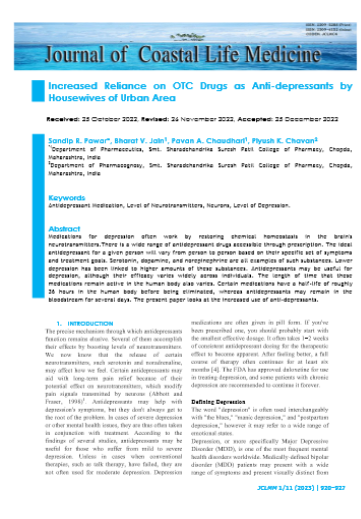Increased Reliance on OTC Drugs as Anti-depressants by Housewives of Urban Area
Main Article Content
Abstract
Medications for depression often work by restoring chemical homeostasis in the brain's neurotransmitters.There is a wide range of antidepressant drugs accessible through prescription. The ideal antidepressant for a given person will vary from person to person based on their specific set of symptoms and treatment goals. Serotonin, dopamine, and norepinephrine are all examples of such substances. Lower depression has been linked to higher amounts of these substances. Antidepressants may be useful for depression, although their efficacy varies widely across individuals. The length of time that these medications remain active in the human body also varies. Certain medications have a half-life of roughly 36 hours in the human body before being eliminated, whereas antidepressants may remain in the bloodstream for several days. The present paper looks at the increased use of anti-depressants.
Article Details
References
Abbott F. V., Fraser M. I. Use and abuse of over-the-counter analgesic agents. Journal of Psychiatry & Neuroscience. 1998;23(1):13–34. [PMC free article] [PubMed] [Google Scholar]
Banerji S., Anderson I. Abuse of Coricidin HBP cough & cold tablets: Episodes recorded by a poison center. American Journal of Health-System Pharmacy. 2001;58(19):1811–1814. [PubMed] [Google Scholar]
Bell K., Salmon A. Pain, physical dependence and pseudoaddiction: Redefining addiction for “nice” people? International Journal on Drug Policy. 2009;20(2):170–178. [PubMed] [Google Scholar]
Chetty R., Baoku Y., Mildner R., Banerjee A., Vallance D., Haddon A., Labib M. Severe hypokalaemia and weakness due to Nurofen misuse. Annals of Clinical Biochemistry. 2003;40(Pt. 4):422–423. [PubMed] [Google Scholar]
Dean J., Rud F. The drug addict and the stigma of addiction. Substance Use & Misuse. 1984;19(8):859–869. [PubMed] [Google Scholar]
Dobbin M., Tobin C. L. Over-the-counter ibuprofen/codeine analgesics: Misuse and harm. Melbourne, VIC: Drugs Policy and Services Branch Department of Human Services; 2008. [Google Scholar]
Ernest D., Chia M., Corallo C. E. Profound hypokalaemia due to Nurofen Plus and Red Bull misuse. Critical Care and Resuscitation. 2010;12(2):109–110. [PubMed] [Google Scholar]
Fleming G. F., McElnay J. C., Hughes C. M. Development of a community pharmacy-based model to identify and treat OTC drug abuse/misuse: A pilot study. Pharmacy World & Science. 2004;26(5):282–288. [PubMed] [Google Scholar]
Goffman E. Stigma: Notes on the management of spoiled identity. London: Penguin Group; 1990. [Google Scholar]
Hughes G. F., McElnay J. C., Hughes C. M., McKenna P. Abuse/misuse of non-prescription drugs. Pharmacy World & Science. 1999b;21(6):251–255. [PubMed] [Google Scholar]
Lambert A. P., Close C. Life-threatening hypokalaemia from abuse of Nurofen Plus. Journal of the Royal Society of Medicine. 2005;98(1):21. [PMC free article] [PubMed] [Google Scholar]
Levine D. A. “Pharming”: The abuse of prescription and over-the-counter drugs in teens. Current Opinion in Pediatrics. 2007;19(3):270–274. [PubMed] [Google Scholar]

